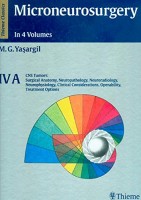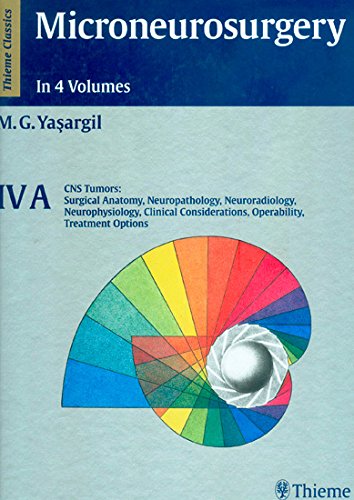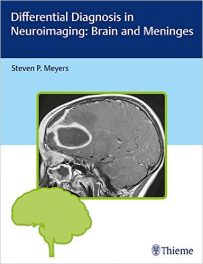 Book Review: Microneurosurgery, IVA – Central Nervous System Tumors: Surgical Anatomy, Neuropathology, Neuroradiology, Neurophysiology, Clinical Considerations, Operability, Treatment Options
Book Review: Microneurosurgery, IVA – Central Nervous System Tumors: Surgical Anatomy, Neuropathology, Neuroradiology, Neurophysiology, Clinical Considerations, Operability, Treatment Options
Editor: M.G. Yasargil, MD
Collaborators: T.E. Adamson, G.F. Cravens, R.J. Johnson, J.D. Reeves, P.J. Teddy, A. Valavanis, W. Wichmann, A.M. Wild, and P.H. Young.
Anatomical Preparations by A. Lang, U. Ture
Illustrated by P. Roth
Publisher: Thieme – 396 pages. 1126 illustrations, 58 tables
Book Review by: Nano Khilnani
This text is part of Volume 4 of a four-volume set.
Volume I is on microsurgical anatomy of the basal cistern and vessels of the brain, diagnostic studies, and general operative techniques and pathological considerations of intracranial aneurysms.
Volume II is on clinical considerations and surgery of intracranial aneurysms and results.
Volume III A is on arteriovenous malformations (AVMs) in the brain, history, embryology, pathological considerations, hemodynamics, diagnostic studies, and microsurgical anatomy.
Volume III B is on AVMs in the brain, clinical considerations, general and special operative techniques, surgical results, non-operated cases, cavernous and venous angiomas, and neuroanesthesia.
Volume IV B is on microsurgery of CNS tumors.
The author M.G. Yasargil points out that the purpose of this textbook is to provide and discuss the reliability of the current basic neuro-scientific investigations and to present clinical observations, management strategies, microsurgical approaches, and operative results in over 3,400 patients with central nervous system (CNS) tumors.
He asserts that the process of making decisions on what is to be done (or not) is based on the following:
- The application of knowledge from several associated disciplines
- Precision in determining the diagnosis, localization, treatment options, and prognosis of each lesion. This is dependent on:
- Accurate neuroanatomical, neurophysiological, neuropathological, neuroinvestigational, and neuroclinical knowledge
- Awareness of the recent remarkable advances in these knowledge areas
The coverage of this large-sized book is extensive, and it is an outstanding value to the student, resident, and practitioner. Its contents are organized into five main sections, as shown below:
Anatomy
- Topographical Anatomy for Microsurgical Approaches to Intrinsic Brain Tumors
- Vascular Anatomy
- Conclusions
Neuropathology
- Introduction
- General Considerations: Categorizations of CNS Tumors
- Specific Considerations
- Brain-Tumor Interface: Adherence and Adhesiveness
- Tumor Vascularization
- The Numbers and Types of Tumors
- Conclusions
- Cases
Neuroradiology
- Historical Review
- Current Neuroimaging with CT and MRI
- The Application of Neuroimaging Capabilities to CNS Tumors
- Summary
- Conclusions
- Cases
Neurophysiology
- Introduction
- Physiological Subsystems
- Pathophysiology: Cerebral Edema
- Cerebrospinal Fluid System
- Circumventrical Organ System
- Neuroendocrine System
- Neurotransmitters
- Central Nervous and Immune Systems
- Pathophysiology of CNS Disease Processes
- Final Remarks
- Conclusions
- Cases
Clinical Considerations – Operability
- General Remarks
- Treatment Option
- Final Comments
References
Dr. Yasargil points out that while neuropathologists, using immunocytochemistry and other techniques, have been able to provide us an “increasingly precise” classification of tumors, “the understanding of fundamental tumor biology is still elusive.”
These specialists have also not been able to yet provide “an accurate method of anticipating growth and growth pattern, spread, migration, or penetration of an individual tumor, the factors which are most helpful in the determination of tumor operability and intensity of treatment.”
Because of the lack of this specific knowledge, it is difficult for surgeons to determine the potential dangers and benefits of operating on both benign and malignant tumors, both on the inside and outside of the body, especially in the initial and intermediate stages of growth and spread of the tumors.
From 1967 until 1975 – the initial period of microsurgery in Zurich – the diagnosis and determination of the benefits and potential risks of operating on CNS tumors were based on: history, physical exam, and imaging thru angiography, EEG, myelography, and pneumoencephalography.
But in the last 17 years, newer and better diagnostic tools have helped physicians to better recognize tumors. Some of these improved visualization methods are: computed tomography (CT) scans, functional and dynamic magnetic resonance imaging (MRI), MR spectroscopy, positron emission tomography (PET), single photon emission computed tomography (SPECT), and Doppler imaging.
Still, other challenges make the job of the neurosurgeon difficult. Even though it is possible to get three-dimensional views of the brain that are quite instructive in diagnosis, these are still “segregated models of reality,” Dr. Yasargil points out. So he says that it would be helpful to have the help of the neuroanatomist, neurophysiologist, and the computer engineer during the pre-operative period.
He writes that he is “convinced” that this will be the reality in the near future, wherein a modern computerized operating room will assist the surgeons in diagnosis and operation for more successful outcomes.
This is a comprehensive textbook in its field, with extensive coverage of numerous related topics, along with excellent illustrations of various types. I would go so far as to say that this book is a must for anyone planning to be in the research or clinical aspect of neurology and neurosurgery.
M.G.Yasargil, MD is Professor and Chairman (Emeritus) of the Department of Neurosurgery at University Hospital in Zurich, Switzerland.







